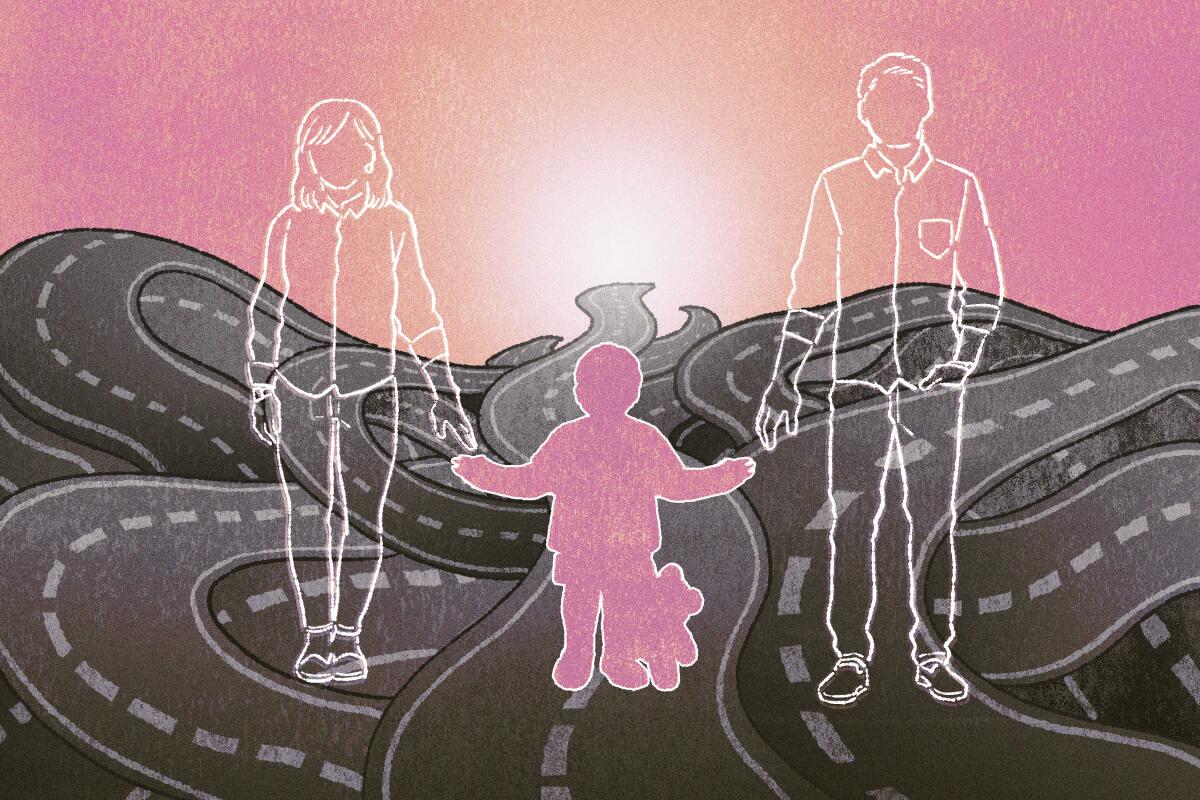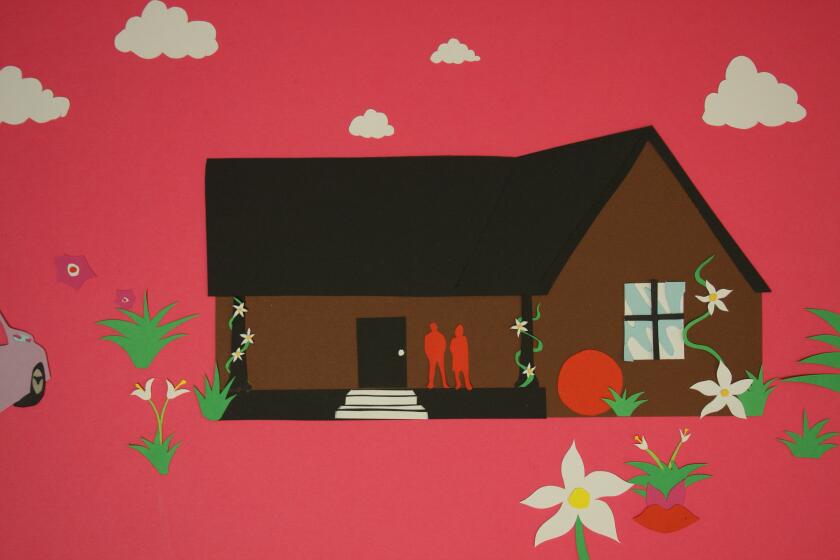Thinking of becoming a foster parent in L.A.? Here’s how

- Share via
Nefertiti Austin’s journey to motherhood started in her 30s. Things she never noticed before — diaper bags, bottles, strollers — were jumping out at her in stores.
“It was really just this overwhelming sense of wanting to be a mother,” Austin said.
Austin didn’t have a partner then and she didn’t mind if she skipped pregnancy. She knew adoption would be the right choice for her.
“At the time, lots of people were adopting from Ethiopia, South Africa and China,” she said. “I wasn’t interested in that.”
Austin knew there were many children in the L.A. area who needed homes. So she applied to become a resource parent, previously called a foster parent.
According to the Child Welfare Indicators Project, more than 58,000 children in California are in the care of their county’s social services department and in the process of joining a resource family. More than 20,000 are in Los Angeles County, where the agency tasked with helping those children is called the Department of Children and Family Services. There are also 51 private agencies in the county that help place foster children in homes.
If You Go
Ask a Reporter: How to be a foster parent
What: Columnist Robin Abcarian in conversation with Charity Chandler-Cole, executive director of CASA of Los Angeles, about how to be a foster parent.
When: 4 p.m., Saturday, April 23
Where: The Ask A Reporter stage at USC, Mudd Hall
Admission: Tickets available online
The Los Angeles Times Festival of Books at USC welcomes more than 500 authors, artists, chefs, celebrities, journalists and musicians on April 23 and 24, 2022. The festival’s Ask A Reporter stage will feature Times staffers discussing some of the most interesting, innovative work at the paper right now.
One of them is the Children’s Bureau, where Cindy Stogel is the foster care and adoption coordinator.
“We try really hard to have the philosophy of, ‘If I couldn’t keep my child and my child had to go to another family, what would I want to know about that family? What would I want to know so that I know my child is safe?’” Stogel said.
If you’re considering fostering a child, you’ll need to learn the process of applying and gaining approval, and you’ll need to answer some challenging questions. You’ll also need to learn about the term “resource parent.” Here’s a guide.
Why ‘resource parent’?
Before you fill out an application, you’ll want to understand why you’ll be called a resource parent and not a foster parent.
In 2015, California enacted Assembly Bill 403, which brought new policies and terms to the foster care system. One notable change in the bill was the transition from the term “foster family” to “resource family.”
The Los Angeles County Department of Children and Family Services said stigma can be attached to the word “foster,” for both the caretaker and child.
“‘Resource parent’ is a term that more precisely defines the services provided by these individuals to the community,” a county spokesperson said via email.
A guide to the literary geography of Los Angeles: A comprehensive bookstore map, writers’ meetups, place histories, an author survey, essays and more.
Who becomes a resource parent?
A resource parent can be a relative of a child, a single person or partners, married or not. Applicants must be at least 18. They can be stay-at-home parents or not; renters or homeowners.
As long as applicants are capable of parenting or co-parenting and are approved by their county’s child and family social services department or a private agency, a child can join their home.
Austin knew biological parents didn’t have to be a child’s guardian. She and her brother were raised by their grandparents, for example, and her best friend was adopted.
“So I knew your parents didn’t necessarily have to give birth to you,” Austin said.
The only hesitancy she had was being a single person applying to be a resource parent. She didn’t know how she would be received during the in-person (this was before the pandemic) training classes.
But, “Once the class got underway, it really focused on who the children are and why they come to the foster care system,” she said. “I felt I was able to shift the focus off myself.”
Anthony, Noah, Gabriel and beyond: How to fix L.A. County DCFS
Are you ready?
There’s a lot to consider when becoming a resource parent. You have to think about the basics: whether you have enough space in your home and time to complete all the necessary paperwork, training and assessments.
But there are more complex questions you have to ask yourself. For example, are you prepared to work with the birth parents of a child? Are you comfortable with the uncertainty of a child’s stay with you?
Stogel and the L.A. County DCFS ask prospective resource parents these questions:
- What is your family’s readiness? Is this the right time?
- Can you provide a child a loving and stable home, as well as access to resources that a child may need for their care?
- Are you going to be making major changes in your life in the next several months — for example, are you moving to a new job?
- Realistically how much time do you have to dedicate to a child?
- Who is your support system?
When you’re reflecting on these questions, another helpful tool is the PRIDE (Parent Resource for Information, Development, and Education) Model of Practice by the Child Welfare League of America. The practice emphasizes that a resource family is part of a team that includes a social worker, an agency (if you work with one) and the child’s birth parents.
Scott Martin-Rowe and his wife had another important teammate: a go-to friend with a prepaid gift card.
The Los Angeles County residents had tried to start a family for five years before deciding to become resource parents with the goal of adopting. They knew foster-to-adoption would work for them because his parents fostered for nearly 10 years. His niece was also adopted through foster care.
When he and his wife submitted their application for the first time and were approved, they were told they could get a call about taking in a child within a few weeks or months. They received a call about their first son, a newborn baby, the following day.
They didn’t have a car seat to pick the baby up in, but Martin-Rowe’s friend with the gift card was able to buy an age-appropriate one while the couple finished their work day.
The couple has since fostered seven children and adopted four; three were reunited with their families. Because they never knew when they would get the call about a child in need, having that go-to friend — who could buy diapers or other essentials too — at a moment’s notice came in handy.
Contributor: I was born into foster care. A mentor would have made a big difference in my life
Nearly 20% of the nation’s foster child population is in California, and many of them would benefit from having mentors. I know I would have.
Apply with an agency or the county?
There are two ways to become a resource parent in L.A. County: You can get a state license to be a resource family through the county Children and Family Services Department or be approved by one of the 51 foster family agencies.
If you decide to get approval from the county, you’ll be categorized as a state-licensed resource family.
If you’re approved through an agency, you’ll be under the agency’s license — in this scenario, the agency is responsible for monitoring families they have certified and have the authority to decertify a family too.
One big difference, Stogel said, is that families who need extra help and attention can get that through Children’s Bureau, for example. If you decide to work with an agency but don’t like how it operates, you can leave it and continue the process with another. You’re not tied to one agency.
Whichever path you take, the requirements for the Resource Family Approval are the same.
How the approval process works
L.A. County DCFS shared this brief breakdown of the approval process:
- Apply: Start by creating an account and completing an online application through the county website. If you cannot complete the application online, call (888) 811-1121.
- Orientation: Once the application is completed, sign up for and attend an orientation. According to the Department of Children and Family Services, the orientation is an opportunity to learn about the approval process, ask questions and decide whether you are ready to become a resource family.
- Background check: You’ll receive a letter instructing you to submit electronic fingerprints, called LiveScan. You will also sign a form allowing the child welfare agency to check for a criminal record and any records of child abuse or neglect.
- Trainings: Prospective resource families are required to attend 12 hours of preapproval and eight hours of preplacement training. The training program informs families about the foster care system, the needs of children and what it means to be a resource family.
- Home assessment: A social worker will schedule a time to meet with you and your family in your home for a basic health and safety inspection and to ensure it is a suitable environment for a child.
- Family evaluation: A social worker will schedule a time to meet with you and your family to begin the family evaluation process. This assessment will help determine your readiness to provide a safe and stable home environment for a foster child.
- Health certifications: Up to 90 days after approval, the family will also need to complete CPR and first-aid certification.
If you’re working with an agency, these steps will be performed by them. The process typically takes four to six months, according to the county.
When a little girl wound up in foster care, she got help to turn her life around. CASA, the program that provided it, needs many more volunteers.
Once a child joins your family
Martin-Rowe noted that with each child you welcome into your home, you’re also welcoming in a new social worker. You’ll get visits from the social worker, and if you’re working with an agency, a case worker will be assigned to visit as well.
If the birth parents or a biological relative has visitation rights, they will also visit your home.
And in addition to normal parenting duties, you’ll make reports for the county or agency.
In Martin-Rowe’s family, some children needed speech therapy. So before the children were adopted, he and his wife would take the children to their appointments and report that back to the case worker.
“Every month you have to submit receipts that show you’re buying the children X amount of clothing, and you have to do all that sort of stuff,” he said.
Every year, the couple needed to recertify to continue being resource parents, a process that includes a walk-through of the home.
What about adoption?
Most families who work with the Children’s Bureau have a goal of adopting a child, Stogel said.
“It’s a lot of work to help families understand that you have to foster first,” she said.
The first priority of the county and placement agencies is reunifying children with their birth families when it is possible to do so.
According to the California Department of Social Services, when a child joins a resource family, a social worker must supervise the family for six or more months before the court approves adoption.
During this time, a relative could petition to become the child’s guardian or a birth parent could petition to reunify with their child, Stogel said.
“You have to go into this with the ability and the willingness to experience a bumpy road with twists and turns,” she said.
The county emphasized that part of a resource parent’s responsibility is to support the possibility of reunification.
“When reunification does occur, resource parents may have a difficult time saying goodbye to a child in their care because they’ve bonded,” a Los Angeles County spokesperson said. “However, most resource parents understand that reunification with biological parents is what is best for children, and they continue on the path of opening their hearts and homes to others.”
Reunification might not be at the top of a resource family’s mind at first because they might believe they could provide a better life for the child.
When Austin went through the preapproval trainings to become a resource parent, she said her biggest takeaway was not to vilify birth parents. When she was a child, Austin felt abandoned by her mother because “she chose a lifestyle and her husband over her children.
“But what I learned in the class is that people are doing the best they can, and my mother made a lot of choices that as she got older she certainly grew to regret,” Austin said.
The class helped her gain a level of empathy and compassion for birth parents. She learned that when a parent loses temporary custody of a child, barriers such as homelessness, jail or addiction can stand in the way of reunification.
For me, a mixed-race child, my ties to racial identity were severed when I entered the foster system unaware of the ethnicities that made my brown skin.
Keep in mind
There is no fast track to getting a child. Stogel said people believe if they go through the county, they’ll have a child join their family faster, but that’s not the case.
Your first foster child might not be the one you adopt. Martin-Rowe said if your goal is to adopt, nothing is certain until the adoption is final.
Expand your support system. Your existing circle of family and friends will not understand what you’re going through, so find other resource parents and families to connect with.
There isn’t a specific timeline for a child to join your family. You just have to be ready at a moment’s notice. Austin said you get one phone call, confirm you can care for the child and “20 minutes later, we’re family.”
You are not alone on this journey. DCFS said the county’s social workers will help connect families with resources to meet the child’s needs. Every child in foster care is automatically enrolled in Medi-Cal to ensure they receive appropriate healthcare at no cost to the resource family. All resource families receive a monthly stipend to cover costs associated with caring for a child.
There should be no stigma around mental health, behavioral health or developmental disabilities services. Martin-Rowe said you’re going to have to be very proactive to get your child whatever resources they need. It’s not a bad thing, he said. It’ll change their life for the better when they receive help.
About The Times Utility Journalism Team
This article is from The Times’ Utility Journalism Team. Our mission is to be essential to the lives of Southern Californians by publishing information that solves problems, answers questions and helps with decision making. We serve audiences in and around Los Angeles — including current Times subscribers and diverse communities that haven’t historically had their needs met by our coverage.
How can we be useful to you and your community? Email utility (at) latimes.com or one of our journalists: Jon Healey, Ada Tseng, Jessica Roy and Karen Garcia.
More to Read
Sign up for The Wild
We’ll help you find the best places to hike, bike and run, as well as the perfect silent spots for meditation and yoga.
You may occasionally receive promotional content from the Los Angeles Times.
















